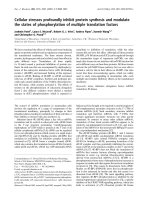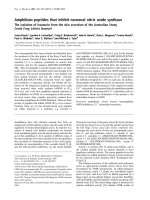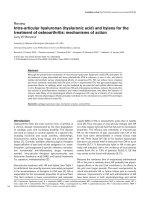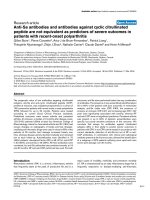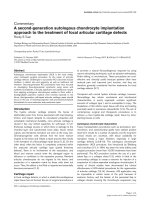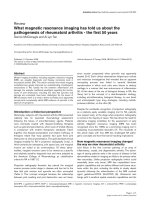Báo cáo y học: "α Anti-α-fodrin antibodies do not add much to the diagnosis of Sjögren’s syndrome" pot
Bạn đang xem bản rút gọn của tài liệu. Xem và tải ngay bản đầy đủ của tài liệu tại đây (62.91 KB, 6 trang )
Introduction
Sjögren’s syndrome (SjS) is a chronic autoimmune
exocrinopathy of unknown origin. Therefore the diagnosis
of SjS, in the absence of a gold standard, is based on cri-
teria containing a number of subjective and objective
signs and symptoms. In the past three decades, several
sets of criteria have been introduced [1–4], in which there
has been a shift from emphasis on subjective symptoms,
such as complaints of dry eyes or dry mouth, towards
objective findings. Recently, a widely supported consen-
sus was established to merge the most frequently used
European (European Study Group [ESG]) and US (San
Diego, San Francisco) classification criteria sets into one
US/European set [5]. The authors of all three major classi-
fication criteria sets previously used took part in this con-
sensus group. In the US/European classification criteria,
more weight is put on the presence of anti-Ro and anti-La
antibodies in the serum, and on the lymphocytic focus
score (LFS) of the sublabial glands, both being objective
signs. The cutoff point of a positive LFS was set at ≥ 1.0,
which ended a long-lasting debate about whether an LFS
of ≥ 1.0 (ESG criteria), > 1.0 (San Francisco criteria), or
≥ 2.0 (San Diego criteria) was most applicable for the
diagnosis of SjS. This agreement ultimately will produce
uniform intercontinental disease prevalence data.
However, the disease specificity of particularly anti-La anti-
ELISA = enzyme-linked immunosorbent assay; ESG = European Study Group; FCS = fetal calf serum; LFS = lymphocytic focus score; NHS =
normal healthy subjects; pGEX-4T2 = α fodrin cDNA in a GST expression vector; RA = rheumatoid arthritis; SjS = Sjögren’s syndrome; SLE =
systemic lupus erythematosus; SS-A = anti-Ro60 (antibodies); SS-B = Anti-La (antibodies); SSc = systemic sclerosis.
Available online />Research article
Anti-
αα
-fodrin antibodies do not add much to the diagnosis of
Sjögren’s syndrome
Michiel M Zandbelt
1
, Judith Vogelzangs
2
, Leo BA van de Putte
1
, Walther J van Venrooij
2
,
Frank HJ van den Hoogen
1
1
Department of Rheumatology, University Medical Center St Radboud, Nijmegen, The Netherlands
2
Department of Biochemistry, University of Nijmegen, The Netherlands
Correspondence: Frank HJ van den Hoogen (e-mail: )
Received: 9 Jun 2003 Revisions requested: 21 Jul 2003 Revisions received: 13 Oct 2003 Accepted: 15 Oct 2003 Published: 31 Oct 2003
Arthritis Res Ther 2004, 6:R33-R38 (DOI 10.1186/ar1021)
© 2004 Zandbelt et al., licensee BioMed Central Ltd (Print ISSN 1478-6354; Online ISSN 1478-6362). This is an Open Access article: verbatim
copying and redistribution of this article are permitted in all media for any purpose, provided this notice is preserved along with the article's original
URL.
Abstract
The presence of anti-α-fodrin autoantibodies has been reported
to be a highly specific and sensitive test for the diagnosis of
Sjögren’s syndrome (SjS). We looked (in Nijmegen) for anti-α-
fodrin, anti-Ro60, and anti-La autoantibodies in a cohort of
51 patients with rheumatic diseases (primary SjS [21],
secondary SjS [6], rheumatoid arthritis [RA] [12], systemic
lupus erythematosus [SLE] [6], and scleroderma [6]) and in
28 healthy subjects, using ELISA, immunoblotting, and
immunoprecipitation. The same samples were analyzed with an
alternative anti-α-fodrin ELISA in Hanover. The Nijmegen ELISA
of the sera from primary SjS showed sensitivities of 43% and
48% for IgA- and IgG-type anti-α-fodrin antibodies, respectively.
The Hanover ELISA showed sensitivities of 38% and 10% for
IgA- and IgG-type anti-α-fodrin antibodies, respectively. The
ELISAs for α-fodrin showed six (Nijmegen) and four (Hanover)
anti-α-fodrin-positive RA sera. IgA and IgG anti-fodrin antibodies
were also present in four patients with secondary SjS. The
sensitivities of Ro60 and La-antibodies in the Nijmegen ELISA
were 67% and 62%, respectively. Unlike anti-α-fodrin
antibodies, all anti-Ro60 and anti-La positive sera could be
confirmed by immunoblotting or RNA immunoprecipitation.
Thus, anti-Ro and anti-La autoantibodies were more sensitive
than anti-α-fodrin autoantibodies in ELISA and were more
frequently confirmed by other techniques. Anti-La antibodies
appear to be more disease-specific than anti-α-fodrin
antibodies, which are also found in RA sera. Therefore, the
measurement of anti-α-fodrin autoantibodies does not add
much to the diagnosis of Sjögren’s syndrome.
Keywords: alpha-fodrin, antibody, ELISA, sensitivity, Sjögren
Open Access
R33
R34
Arthritis Research & Therapy Vol 6 No 1 Zandbelt et al.
bodies is limited (besides being found in SjS, they are also
found in systemic lupus erythematosus [SLE]), and the
sensitivities of anti-Ro and anti-La antibodies range only
from 60–75% and 30–50%, respectively [6–9]. There-
fore, the search for more sensitive and specific diagnostic
markers needs to be continued.
Haneji and co-workers [10] suggested a 120-kDa cleav-
age product of α-fodrin (a cytoskeletal protein) as a candi-
date autoantigen in SjS. They reported that the presence
of anti-α-fodrin antibodies was very specific for the diag-
nosis of SjS and claimed a very high sensitivity (96%). In
another report of the same group, however, these antibod-
ies were also found in some sera of patients with SLE
[11]. Their results suggested that anti-α-fodrin antibodies
might replace anti-Ro and anti-La antibodies, as a more
objective serological marker to improve the diagnostic
value of classification criteria. This suggestion was sup-
ported by Witte and co-workers, who developed an ELISA
for the detection of anti-α-fodrin antibodies and showed
that IgA antibodies against α-fodrin provided an even
higher sensitivity than IgG antibodies [12].
The objective of this study was to measure the presence of
anti-α-fodrin antibodies in the sera of a cohort of patients
with well-defined SjS at the Department of Rheumatology
of the University Medical Center St Radboud, Nijmegen,
The Netherlands. A second objective was to evaluate
whether positive anti-fodrin ELISA results could be con-
firmed by at least one alternative biochemical technique
such as immunoblotting or protein immunoprecipitation.
Materials and methods
Patients and measurement techniques
The sera of 21 patients (18 women and 3 men, aged
27–76 years, median 55 years) with well-defined primary
SjS according to the US/European criteria [5] were tested
along with the sera of 6 patients with secondary SjS (all
women, aged 41–55 years), 28 normal healthy subjects
(NHS) (19 women and 9 men, aged 24–61 years, median
43 years), 12 patients with rheumatoid arthritis (RA) and
without signs of secondary SjS (8 women and 4 men,
aged 32–72 years, median 47 years), 6 with SLE (all
women, aged 33–56 years), and 6 with systemic sclerosis
(SSc) (3 women and 3 men, aged 36–49 years).
All the patients tested were white. To fulfill the US/Euro-
pean classification criteria, all SjS patients had to have a
biopsy of the sublabial salivary glands showing an LFS
≥ 1.0. Furthermore, immunohistochemical examination had
to show a percentage IgA-containing plasma cells of less
than 70, a feature that is also strongly associated with SjS
and slightly more disease specific than the LFS [13,14].
The comorbidity of the six patients with secondary SjS is
shown in Table 1. Secondary SjS was accompanied by
SLE in four patients, by systemic sclerosis in another
patient, and by dermatomyositis in yet another. None of
the SjS patients was receiving an immunosuppressant.
The presence of anti-α-fodrin antibodies in the sera was
measured with three different biochemical techniques:
ELISA, immunoblotting with recombinant fodrin, and
immunoprecipitation of radiolabeled fodrin. Furthermore, a
blinded set of our serum samples was analyzed by Witte
and co-workers using the anti-α-fodrin ELISA developed in
Hanover, Germany (referred to as Hanover ELISA) [12].
Expression of the 120-kDa
αα
-fodrin fragment
For the expression of the antigenic fodrin fragment, we
used the α-fodrin cDNA in a GST expression vector
(pGEX-4T2), which was kindly supplied by Dr Y Hayashi
(Tokushima University School of Dentistry, Tokushima,
Japan). The cDNA was expressed in BL21 (DE3) cells,
and the protein was affinity-purified using glutathione
Sepharose beads (Amersham Pharmacia Biotech).
ELISA
The presence of IgA, IgG, and IgM anti-α-fodrin antibodies
in sera in 100-fold dilution was assessed by ELISA. Plates
were coated with purified α-fodrin–GST as antigen, and
bound antibody was detected essentially as described by
Schellekens and colleagues [15], using rabbit peroxidase-
conjugated anti-human immunoglobulins (anti-IgG, anti-
IgA, or anti-IgM, DAKO, Glostrup, Denmark).
Sera were considered positive when the optical density at
λ 450 nm values after correction for background value
exceeded the mean +2
SD of that of a pool of sera from
NHS. All ELISAs were performed in duplicate. To check
for possible false-positive results because of the presence
of the GST moiety in the α-fodrin–GST product that was
used as the antigen, the ELISA was also performed in the
presence of a 10-fold excess of purified carrier GST.
Anti-La (SS-B) and anti-Ro60 (SS-A) autoantibodies were
measured by ELISA, using recombinant La and Ro60 pro-
teins. All sera were also analyzed by immunoblotting and
RNA immunoprecipitation to confirm the presence of anti-
Ro and anti-La antibodies, as previously described [16].
Immunoblotting
To confirm the ELISA results, reactivity of sera against
recombinant fodrin–GST was evaluated by western
blotting essentially as described elsewhere [17]. The
human sera were diluted 5000-fold with blocking buffer. A
second antibody directed against total human
immunoglobulin was used (DAKO, Glostrup, Denmark). In
a similar type of experiment, immunoblots containing
extracts from apoptotic Jurkat cells, prepared according to
the method of Zampieri and colleagues [18] and believed
to contain the native and possibly modified apoptotic α-
fodrin fragment of 120 kDa described by Haneji and
R35
coworkers, were used. Visualization was performed by
chemiluminescence.
Immunoprecipitation of radiolabeled
αα
-fodrin
For labeling of cellular proteins, HeLa cells were incu-
bated in medium without methionine and supplied with
2% dialyzed fetal calf serum (FCS). After 1 hour, 10 µCi
[
35
S]methionine per ml was added and the concentration
of dialyzed FCS was raised to 5%. After an additional
4 hours, 1 volume of complete medium containing 10%
FCS (undialyzed) was added and incubation was contin-
ued for 16 hours at 37°C. The cells were collected by
Available online />Table 1
Autoantibodies in Nijmegen sera from a cohort of patients with Sjögren’s syndrome
IgA
a
IgG
b
Pt no. Nijmegen Hanover
c
Nijmegen Hanover
c
IB
d
IP
e
Ro60
f
La
g
LFS
h
Comorbidity
Primary Sjögren’s syndrome
1+++–––+–+
2–––––––++
3+–––––––+
4+++–––+–+
5+++–+++++
6+––––++++
7+–––––––+
8–+––––––+
9–++–––+–+
10+++––++++
11––––––+++
12––––+–+–+
13––+–––+++
14––––+++++
15––+–––+++
16––––+–––+
17––+–––+++
18++–––––++
19––––+–––+
20++++––+++
21––++––+++
Secondary Sjögren’s syndrome
22+++–+++++SLE
23+++++++++SLE
24––––––+–+SLE
25++++++––+SLE
26+++–+–+++SSc
27––+–––+–+DM
a
IgA, ELISA measuring presence of IgA antibodies directed against α-fodrin;
b
IgG, ELISA measuring presence of IgG antibodies directed against
α-fodrin;
c
findings in Hanover for the sera originally tested in Nijmegen;
d
IB, immunoblotting results (α-fodrin);
e
IP, protein immunoprecipitation
results (α-fodrin);
f
Ro60, ELISA measuring presence of antibodies directed against Ro60-antigen;
g
La, ELISA measuring presence of antibodies
directed against La-antigen;
h
LFS, lymphocytic focus score ≥ 1.0 in sublabial minor salivary glands biopsy. DM, dermatomyositis; Pt, patient;
SSc, systemic sclerosis; SLE, systemic lupus erythematosus.
centrifugation, washed, and homogenized in lysis buffer
(50 m
M Tris/HCl, pH7.5, 0.5% NP40, 100mM KCl, 1mM
dithioerythritol, 1 mM EDTA) containing a mixture of pro-
tease inhibitors. IgG antibodies from sera to be analyzed
(SjS and controls) were coupled to protein A-agarose
beads (Biozym, Landgraaf, The Netherlands) and immuno-
precipitations were carried out as described by Raijmak-
ers and colleagues [17].
Hanover ELISA confirmation
Another way to confirm our ELISA results was to compare
our data with those obtained with the Hanover ELISA
developed by Witte and colleagues [12]. A blinded set of
serum samples was therefore analyzed in Hanover.
Results
Analysis for anti-
αα
-fodrin, anti-La, and anti-Ro60 by ELISA
Using the purified α-fodrin–GST protein encoded by the
cDNA construct obtained from Dr Hayashi, we developed
an ELISA (hereafter referred to as the Nijmegen ELISA)
that was used for the analysis of SjS and control sera. The
Nijmegen IgA ELISA test appeared to be reasonably spe-
cific. Only one serum positive for anti-α-fodrin was found
among the 12 RA sera. In the 28 NHS sera and 12 sera
from SLE and SSc patients, no IgA anti-α-fodrin antibod-
ies were detected. In the IgG ELISA, however, six RA sera
were positive; the other control sera (NHS, SLE, and SSc)
were negative.
Of the 21 sera from primary SjS, 10 were found positive in
the IgG ELISA, indicating a disease sensitivity of IgG anti-
bodies against α-fodrin of 48%. Nine (43%) of the
21 primary SjS sera were found to contain IgA antibodies
against α-fodrin (Table 1) and 3 (14%) of the 21 con-
tained IgM antibodies against α-fodrin (not shown). Five of
the nine primary SjS sera with IgA antibodies to fodrin also
contained IgG antibodies directed against this antigen.
To be sure that the antibodies measured were directed
against the fodrin part of the fodrin–GST fusion protein,
the ELISAs were also carried out in the presence of a
10-fold excess of purified GST protein. Essentially the
same results were obtained.
The same sera (blinded) were also analyzed in Hanover by
Witte and coworkers using their α-fodrin ELISA [12]. The
Hanover results showed a disease sensitivity of 38% for
IgA and of 10% for IgG antibodies against α-fodrin. Six of
8 sera from primary SjS that were positive in the Hanover
IgA ELISA were also positive in the Nijmegen ELISA, so
that 6 of 21 sera from primary SjS (29%) conclusively
seemed to contain IgA antibodies directed against
α-fodrin. While the data for IgA-positive sera from both
ELISAs were quite congruent, data for IgG-positive sera
showed clear discrepancies (Table 1). We do not know
why.
We also looked for the classic anti-La and anti-Ro60
autoantibodies in the 21 sera from primary SjS. Fourteen
sera contained anti-Ro60 (SS-A) antibodies (sensitivity
67%) and 13 sera contained anti-La (SS-B) antibodies
(sensitivity 62%). These activities were confirmed by at
least one other technique (immunoblotting and/or RNA
precipitation). Anti-La and anti-Ro activities were absent in
all control sera that were included in this study (data not
shown). There was also considerable overlap between the
presence of anti-α-fodrin and anti-Ro60 or anti-La. Of the
9 IgA-positive sera from primary SjS, 6 contained anti-
Ro60 and 5 contained anti-La, while of the 10 IgG-posi-
tive sera, all contained anti-Ro60 also and 7 contained
anti-La antibodies (Table 1).
Four of six sera from patients with secondary SjS con-
tained IgA and IgG antibodies against α-fodrin. Three of
these sera also contained anti-Ro and anti-La antibodies
(Table 1). From these results we conclude that anti-
α-fodrin antibodies are present in SjS sera and that the
majority of these antibodies are of the IgG and IgA class,
but that their frequency in SjS sera is not higher than that
of the classic autoantibodies directed against the Ro60
and La antigens.
Analysis for anti-
αα
-fodrin antibodies by western
blotting and immunoprecipitation
We also analyzed the sera for anti-α-fodrin antibodies by
two other techniques (immunoblotting and protein
immunoprecipitation) to confirm the ELISA results. In
general, these two techniques appeared to be less suited
for this purpose. The size of the antigen (250 kDa) and its
limited presence in cultured cells precluded both efficient
blotting and efficient labeling by [
35
S]methionine. There
were also some background problems that in some cases
made it difficult to distinguish between positive and nega-
tive sera. We therefore decided to count only those sera
that were clearly positive.
Of the sera from primary SjS, five appeared to be positive
in immunoblotting and four precipitated a protein with the
expected molecular weight of fodrin. Two of those that
immunoprecipitated fodrin were also positive on
immunoblot, and three also contained IgA and/or IgG anti-
bodies to α-fodrin as measured by ELISA (Table 1).
The presence of anti-fodrin antibodies in four sera of
patients with secondary SjS was confirmed by
immunoblotting (four of four) and by immunoprecipitation
(three of four) (Table 1).
In our hands, the use of apoptotic extracts (to increase the
amount of antigenic fodrin cleavage product) did not
improve the suitability of these techniques for the detec-
tion of anti-α-fodrin antibodies (data not shown).
Arthritis Research & Therapy Vol 6 No 1 Zandbelt et al.
R36
Discussion
The presence of anti-Ro and anti-La autoantibodies has
been part of the classification criteria for Sjögren’s syn-
drome (SjS), including the recently established US/Euro-
pean consensus group criteria, in which they play a more
significant role than before [5]. According to these classifi-
cation criteria, the presence of either anti-Ro or anti-La
autoantibodies or a positive salivary gland biopsy (LFS
≥ 1.0) is mandatory for the classification of SjS. The
disease sensitivities of anti-Ro and anti-La autoantibodies
have been reported to be 60–75% and 30–50%, respec-
tively [6–9], while the specificity of particularly anti-La
autoantibodies is generally considered to be reasonably
high. Anti-La autoantibodies are mostly found in SjS and
SLE patients, and rarely in other diseases or normal
healthy subjects. Nevertheless, there is certainly a need
for an SjS-specific autoantibody showing a better disease
sensitivity and specificity profile.
Haneji and colleagues suggested the presence of anti-α-
fodrin autoantibodies as a highly specific diagnostic
marker for SjS. In their initial paper, they reported that
96% of sera from primary SjS reacted with α-fodrin [10].
In follow-up studies, however, they also noticed the pres-
ence of these autoantibodies in SLE patients [11]. Witte
and collaborators showed much lower disease sensitivi-
ties, of 64% and 47% in primary and secondary Sjögren’s
syndrome, respectively, when focusing on IgA antibodies
against α-fodrin rather than IgG antibodies [12]. Their
data suggest a sensitivity similar to that of anti-Ro antibod-
ies. However, Witte and co-workers also noticed two posi-
tive sera in RA patients without symptoms of SjS, and one
positive serum in the SLE group. These results indicate
that the disease specificity of anti-α-fodrin antibodies
might also be lower than reported previously.
In our cohort of patients with primary SjS, the ELISA tests
of 21 sera showed sensitivities of 43% and 48% for IgA
antibodies and IgG antibodies against α-fodrin, respec-
tively; these are comparable to the percentages reported
by Witte and co-workers. In the blinded set of control sera
analyzed in Nijmegen and Hanover, no positive tests were
found in the NHS, SLE, or SSc sera, suggesting that the
ELISA tests in both laboratories are specific. However, of
the 12 RA sera tested in Hanover, four gave positive
results in the IgA ELISA, including the one that was also
positive in Nijmegen. Of the six RA sera that were positive
in the IgG ELISA in Nijmegen, three were also positive in
the IgG ELISA of Hanover. These data, together with the
previously reported positive RA sera by Witte and co-
workers, indicate that the presence of anti-fodrin antibod-
ies in a subset of RA patients cannot be ruled out.
Although in this study disease specificity was not evalu-
ated against a large variety of control sera from other dis-
eases, these results suggest that the disease specificity of
anti-fodrin antibodies is unlikely to exceed that of anti-La
antibodies, which are almost exclusively found in either
SjS or SLE sera. Elucidating the precise disease speci-
ficity of anti-fodrin antibodies, which was not the aim of
this study, can be done when larger cohorts of patients
are available.
It should also be noted that anti-Ro- and anti-La- antibod-
ies themselves are part of the US/European classification
criteria, which may bias comparison between the classical
versus anti-fodrin antibodies by means of these criteria. To
overcome this potential problem, the presence of classical
versus anti-fodrin antibodies in SjS patients can also be
related to findings of the single next most important objec-
tive tool: the salivary gland biopsy. Since in our study all
patients that were defined as having SjS at least had to
have a positive LFS, the conclusions remain the same.
This study also showed that there are discrepancies
between the two anti-fodrin ELISA systems. An explana-
tion of this imperfect reproducibility between the two labo-
ratories might be that the titers of anti-α-fodrin antibodies
in patient sera were generally low in both ELISA systems.
Consequently, small changes in the protocol would
become important for the outcome. These observations
underline once more the importance of an easy-to-perform
alternative biochemical technique to confirm ELISA data
[19].
Conclusion
Based on the difficulties encountered in this study to
confirm the presence of anti-fodrin antibodies via alterna-
tive techniques, it is questionable whether anti-fodrin anti-
bodies should replace the classic anti-Ro and anti-La
antibodies in the classification criteria of SjS.
All anti-Ro and anti-La activities in our sera detected by
ELISA could be confirmed using alternative biochemical
techniques. Besides that, the observed sensitivity of these
classic autoantibodies is higher than that of anti-α-fodrin
antibodies, regardless of the anti-fodrin ELISA system
(Hanover versus Nijmegen ELISA) that was used. In addi-
tion, a considerable overlap between the presence of anti-
Ro60/anti-La antibodies and anti-α fodrin antibodies was
observed. A potential contributing role for the measure-
ment of anti-fodrin antibodies to detect SjS patients who
are negative for anti-Ro60 and anti-La autoantibodies
therefore appears unlikely. Anti-fodrin antibodies may still
have some diagnostic value assuming that their incidence
in SLE sera is low, which has yet to be confirmed in addi-
tional studies.
Based on the lower frequency, as compared to anti-Ro
and anti-La, and the questionable specificity, we conclude
that testing for anti-α-fodrin antibodies does not have
much additional value for the diagnosis of Sjögren’s syn-
drome.
Available online />R37
Competing interests
None declared.
Acknowledgements:
We are very grateful to Dr T Witte and Dr R Schmidt (Abteilung Klinis-
che Immunologie, Medizinische Hochschule Hanover, Hanover,
Germany) for their help in analyzing our sera with their anti-fodrin ELISA
and for their comments on the manuscript. We are most grateful to Dr
Y Hayashi (Department of Pathology, Tokushima University School of
Dentistry, Tokushima, Japan) for providing us with the α-fodrin cDNA
construct. We thank Dr W Degen and laboratory technician B de Jong
(Department of Biochemistry, University of Nijmegen, Nijmegen, The
Netherlands) for excellent technical assistance.
References
1. Vitali C, Bombardieri S, Moutsopoulos HM, Coll J, Gerli R, Hatron
PY, Kater L, Konttinen YT, Manthorpe R, Meyer O, Mosca M,
Ostuni P, Pellerito RA, Pennec Y, Porter SR, Richards A, Sauvezie
B, Schiodt M, Sciuto M, Shoenfeld Y, Skopouli FN, Smolen JS,
Soromenho F, Tishler M, Wattiaux MJ: Assessment of the Euro-
pean classification criteria for Sjogren’s syndrome in a series
of clinically defined cases: results of a prospective multicen-
tre study. The European Study Group on Diagnostic Criteria
for Sjogren’s Syndrome. Ann Rheum Dis 1996, 55:2:116-121.
2. Daniels TE: Clinical assessment and diagnosis of immunologi-
cally mediated salivary gland disease in Sjogren’s syndrome.
J Autoimmun 1989, 2:529-541.
3. Fox RI, Saito I: Criteria for diagnosis of Sjogren’s syndrome.
Rheum Dis Clin North Am 1994, 20: 391-407.
4. Homma M, Tojo T, Akizuki M, Yamagata H: Criteria for Sjogren’s
syndrome in Japan. Scand J Rheumatol 1986, Suppl 61:26-27.
5. Vitali C, Bombardieri S, Jonsson R, Moutsopoulos HM, Alexander
EL, Carsons SE, Daniels TE, Fox PC, Fox RI, Kassan SS, Pillemer
SR, Talal N, Weisman MH: Classification criteria for Sjogren’s
syndrome: a revised version of the European criteria pro-
posed by the American-European Consensus Group. Ann
Rheum Dis 2002, 61: 554-558.
6. Hansen B, Manthorpe R: Antibodies against SS-B/La and SS-
A/Ro antigens in patients with primary Sjogren’s syndrome.
Scand J Rheumatol 1986, Suppl 61:93-97.
7. Reichlin M: Antibodies to Ro and La. Ann Med Interne 1998,
149:34-41.
8 Beer R.G, Rischmueller M, Coates T, Purcell AW, Keech CL,
McCluskey J, Gordon TP: Nonprecipitating anti-La(SS-B)
autoantibodies in primary Sjogren’s syndrome. Clin Immunol
Immunopathol 1996, 79: 314-318.
9. Venables PJ, Shattles W, Pease CT, Ellis JE, Charles PJ, Maini
RN: Anti-La (SS-B): a diagnostic criterion for Sjogren’s syn-
drome? Clin Exp Rheumatol 1989, 7: 181-184.
10. Haneji N, Nakamura T, Takio K, Yanagi K, Higashiyama H, Saito I,
Noji S, Sugino H, Hayashi Y: Identification of alpha-fodrin as a
candidate autoantigen in primary Sjogren’s syndrome.
Science 1997, 276:604-607.
11. Watanabe T, Tsuchida T, Kanda N, Mori K, Hayashi Y, Tamaki K:
Anti-alpha-fodrin antibodies in Sjogren syndrome and lupus
erythematosus. Arch Dermatol 1999, 135:535-539.
12. Witte T, Matthias T, Arnett FC, Peter HH, Hartung K, Sachse C,
Wigand R, Braner A, Kalden JR, Lakomek HJ, Schmidt RE: IgA
and IgG autoantibodies against alpha-fodrin as markers for
Sjogren’s syndrome. Systemic lupus erythematosus. J
Rheumatol 2000, 27:2617-2620.
13. Bodeutsch C, de Wilde PC, Kater L, van Houwelingen JC, van
den Hoogen FH, Kruize AA, Hene RJ, van de Putte LB, Vooijs GP:
Quantitative immunohistologic criteria are superior to the
lymphocytic focus score criterion for the diagnosis of Sjo-
gren’s syndrome. Arthritis Rheum 1992, 35:1075-1087.
14 Zandbelt M.M, Wentink JR, de Wilde PC, van Damme PA, van de
Putte LB, van den Hoogen FH: The synergistic value of focus
score and IgA% score of sublabial salivary gland biopsy for
the accuracy of the diagnosis of Sjogren’s syndrome: a 10-
year comparison. Rheumatology 2002, 41:819-823.
15. Schellekens GA, Visser H, de Jong BA, van den Hoogen FH,
Hazes JM, Breedveld FC, van Venrooij WJ: The diagnostic prop-
erties of rheumatoid arthritis antibodies recognizing a cyclic
citrullinated peptide. Arthritis Rheum 2000, 43:155-163.
16 Rutjes S.A, Vree Egberts WT, Jongen P, Van den Hoogen F,
Pruijn GJ, van Venrooij WJ: Anti-Ro52 antibodies frequently co-
occur with anti-Jo-1 antibodies in sera from patients with idio-
pathic inflammatory myopathy. Clin Exp Immunol 1997, 109:
32-40.
17. Raijmakers R, Noordman YE, van Venrooij WJ, Pruijn GJ: Protein-
protein interactions of hCsl4p with other human exosome
subunits. J Mol Biol 2002, 315:809-818.
18. Zampieri S, Degen W, Ghiradello A, Doria A, van Venrooij WJ:
Dephosphorylation of autoantigenic ribosomal P proteins
during Fas-L induced apoptosis: a possible trigger for the
development of the autoimmune response in patients with
systemic lupus erythematosus. Ann Rheum Dis 2001, 60:72-
76.
19. Charles PJ, van Venrooij WJ, Maini RN: The Consensus Work-
shops for the Detection of Autoantibodies to Intracellular
Antigens in Rheumatic Diseases: 1989-1992. Clin Exp
Rheumatol 1992, 10:507-511.
Correspondence
FHJ van den Hoogen, MD, Department of Rheumatology, UMC St
Radboud, Nijmegen, PO Box 9101, 6500 HB Nijmegen, The
Netherlands. Tel: +31 24 3614580; fax: +31 24 3541433; e-mail:
Arthritis Research & Therapy Vol 6 No 1 Zandbelt et al.
R38

